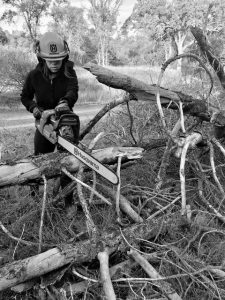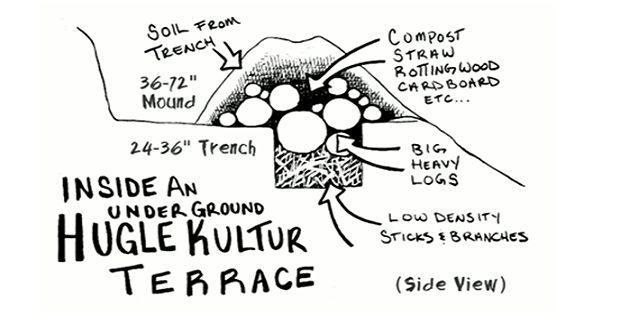By Brian Moore —
MOUNTAIN AREA — Hugelkultur builds garden mounds using tree trunks, limbs, branches, leaves, decaying organic matter (compost) and soil as a planting base. Hugelkultur mimics a forest floor’s process of decomposition and regeneration. Hugelkultur can improve soil vibrancy, water holding ability and soil heating. But what is with the name?
In the late 1970’s two German horticulturists, Hans Beba and Herman Andra, coined this German word which in English translates as, “hill culture,” describing a permaculture method Sepp Holzer (Austrian author of Permaculture) was popularizing around the world.
Hugelkultur uses what the earth is decomposing to naturally grow produce. Deciduous tree branches less than three inches in diameter are ideal for hugelkultur. One good recipe for a hugelkultur comes from the University of California’s Master Gardener Program Monterey and Santa Cruz Counties.
- Dig a trench, lining it with thin branches
- Lay down logs and thick twigs
- Layer a pile of dead leaves or dry straw
- Spread lawn clipping or green leaves
- Pat in a layer of mature compost
- Shovel six inches of soil on top
- Sprinkle with your favorite mulch
The hugelkultur can be planted after construction and needs to be initially watered.
 Compared to conventional gardening, the decomposing biomass of a hugelkultur garden releases more nutrients and increases microbial and soil fertility as the years pass. A five-year-old mound should out-produce the first year crop up to five fold.
Compared to conventional gardening, the decomposing biomass of a hugelkultur garden releases more nutrients and increases microbial and soil fertility as the years pass. A five-year-old mound should out-produce the first year crop up to five fold.
Hugelkultur mounds can be small enough for a corner backyard garden or large enough for a commercial production. The mound can be free standing or bound by material like rock, wood or hay bales. Hugelkultur gardens are drought resistant, create twice the planting surface of row or raised beds, and prevent soil compaction. The downside of putting in a hugelkultur garden includes the need to continually add small branches, supplement compost and soil to the garden, and mounds gradually sink down into the soil they are raised on.
The types of trees and branches you use may influence the hugelkultur’s productivity. Black Walnut, Pepper, Sycamore, American elm, Oaks, Sycamore, Manzanita, California Bay laurel, Cottonwood, Forsythia, Tree-of-heaven, Black locus and Eucalyptus may inhibit the establishment of new plant growth because of their allopathic chemical seedling inhibitors. Pines and furs will break down slowly but are not allopathic.
Hugelkultur is a resourceful way to use downed trees and improve soil fertility introducing another way to creatively garden.
Brian Moore is a Mariposa Master Gardener
Visit our UCMG website
Follow us on Facebook
Listen to local interviews on KRYZ, 98.5 FM
The U.C. Master Gardener Helpline and Helpdesk are staffed Thursdays from 2 – 5 p.m. Please contact the helpline, or leave a message by phone at: (209) 966-7078 By email (send photos and questions for researched answers) to: mgmariposa@ucdavis.edu
Master Gardener Office Location:
UC Cooperative Extension Office,, 5009 Fairgrounds Road, Mariposa, CA 95338
Phone: (209) 966-2417
Email: mgmariposa@ucdavis.edu
Website: http://cemariposa.ucanr.edu/Master_Gardener/



